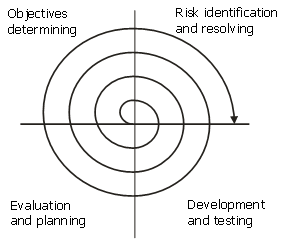CSC/ECE 517 Fall 2012/SM sm: Difference between revisions
| (8 intermediate revisions by the same user not shown) | |||
| Line 2: | Line 2: | ||
<font size="5">The Spiral Model</font> | <font size="5">The Spiral Model</font> | ||
</p> | </p> | ||
== Illustration == | == Illustration == | ||
Spiral model is also called as “meta-model”, The name comes from the way the Spiral Model incorporates other Models in the Software Development Life-Cycle. Both waterfall and prototype models are those that are used most often in it. The Software development progresses systematically over the loops (adhering to waterfall approach) and at the same time prototypes are created and displayed to the user after completion of various phases. This ensures a systematic approach with minimal chances of risks.<Ref name="reft">Illustration http://www.ianswer4u.com/2011/12/spiral-model-advantages-and.html</ref> | Spiral model is also called as “meta-model”, The name comes from the way the Spiral Model incorporates other Models in the Software Development Life-Cycle. Both waterfall and prototype models are those that are used most often in it. The Software development progresses systematically over the loops (adhering to waterfall approach) and at the same time prototypes are created and displayed to the user after completion of various phases. This ensures a systematic approach with minimal chances of risks.<Ref name="reft">Illustration http://www.ianswer4u.com/2011/12/spiral-model-advantages-and.html</ref><br/> | ||
<center>[[File:Image002.png]]</center> | |||
[[File: | <br/> | ||
== Advantages of The Spiral Model== | == Advantages of The Spiral Model== | ||
| Line 138: | Line 53: | ||
== References == | == References == | ||
<references/> | <references/> | ||
==See Also== | |||
[http://users.csc.calpoly.edu/~jdalbey/308/Lectures/SoftwareProcessModels.html Software Process Models]<br/> | |||
[http://www.ctg.albany.edu/publications/reports/survey_of_sysdev?chapter=9 Spiral Model Survey]<br/> | |||
[http://searchsoftwarequality.techtarget.com/definition/spiral-model Spiral Model Design]<br/> | |||
[http://myprojects.kostigoff.net/methodology/development_models/development_models.htm Understanding Spiral Models]<br/> | |||
[http://www.youtube.com/watch?v=YMbAdgb6pG8 Software Models]<br/> | |||
[http://www.buzzle.com/editorials/1-13-2005-64082.asp Introduction to the Spiral Model]<br/> | |||
[http://my.safaribooksonline.com/book/software-engineering-and-development/9781934015551/software-development-life-cycle-models/spiral_model The Spiral Software Model ]<br/> | |||
Latest revision as of 01:07, 27 October 2012
The Spiral Model
Illustration
Spiral model is also called as “meta-model”, The name comes from the way the Spiral Model incorporates other Models in the Software Development Life-Cycle. Both waterfall and prototype models are those that are used most often in it. The Software development progresses systematically over the loops (adhering to waterfall approach) and at the same time prototypes are created and displayed to the user after completion of various phases. This ensures a systematic approach with minimal chances of risks.<Ref name="reft">Illustration http://www.ianswer4u.com/2011/12/spiral-model-advantages-and.html</ref>

Advantages of The Spiral Model
Spiral Model is one of the most used Software Development Models and is known for it’s efficiency, accuracy and straight forward design. Following are various advantages of the Spiral Model:<ref name="refx">Spiral Model - Advantages
http://www.ianswer4u.com/2011/12/spiral-model-advantages-and.html#axzz2ARqc6EGX</ref>
- The Spiral Life-Cycle Model is one of the most flexible SDLC models in software Development. Various phases in Development can be determined by the project manager, based on the complexity of the project.
- Monitoring is very easy, effective and efficient. Each phase, as well as each loop, requires a review from concerned people. This facilitates transparency in the model.
- Risk management is one of the in-built features of the model, which makes up for an added advantage compared to other models.
- Changes in the model can be introduced at a later stage. The person in charge of the project is given enough flexibility to incorporate these changes.
- Estimates about the project including the time taken, cost and schedule become more accurate as the development progresses.
- The Spiral Model is highly adaptive for High-Risk projects, where business needs may be unstable.
- A heavier emphasis is present on Customization, ensuring heavy customizability.
Disadvantages of the Spiral Model
Despite the various advantages Spiral Model brings in, it also has a few considerable disadvantages:<ref name="refy">Spiral Model - Disadvantages http://www.ianswer4u.com/2011/12/spiral-model-advantages-and.html#axzz2ARqc6EGX</ref>
- The Spiral Model might involve higher costs, although it can accurately estimate the numbers.
- The model might become complicated even for projects with a clear Software-Requirements-Specifications.
- Evaluation and reviews of the Spiral Model might require advanced skills, though not true in all cases.
- In order to effectively implement this model, the protocols and standards must be followed carefully, as any small change in the implementation might cause considerable changes to the development process.
- If the requirements of the project change in the future, using the same prototype might get difficult.
- Involves extensive documentation in the intermediate stages during which management of the project might get difficult.
- Not suitable for Low Risk projects.
Applications of The Spiral Model
The Spiral model is used most often in large projects and needs constant review to stay on target. Given the disadvantages of the Spiral Model that are cited above, the Agile Software Development Model can act as a viable alternative. <ref name=”refz”> Applications of Spiral Model http://en.wikipedia.org/wiki/Spiral_model#Applications</ref>
- The military had adopted the spiral model for its Future Combat Systems program. The FCS
project was eventually canceled after six years (2003–2009). it had a two year iteration (spiral).
- The FCS originally should have resulted in three consecutive prototypes (one prototype per spiral—every two years).
The above application of the Spiral Model indicates that the spiral model thus may suit small
(up to $3 million) software applications and not a complicated ($3 billion) distributed,
interoperable, system of systems.
- Also it is reasonable to use the spiral model in projects where business goals are unstable but the architecture is realized well enough to provide high loading and stress ability. For example, the Spiral Architecture Driven Development is a spiral-based Software Development Life Cycle which shows one possible way how to reduce the risk of non-effective architectures with the help of a spiral model in conjunction with the best practices from other models.
References
<references/>
See Also
Software Process Models
Spiral Model Survey
Spiral Model Design
Understanding Spiral Models
Software Models
Introduction to the Spiral Model
The Spiral Software Model